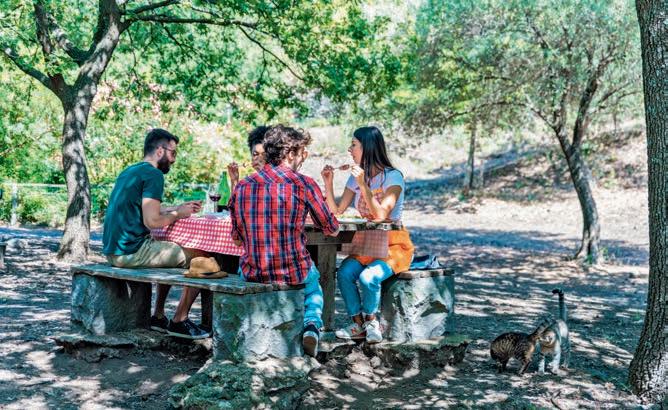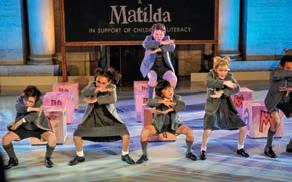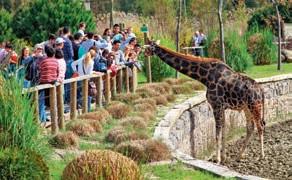Connected
CAMBRIDGE ENGLISH
• B1 Preliminary for Schools (PET)
• B2 First for Schools (FCE)
• C1 Advanced (CAE)
IELTS – International English Language Testing System
INVALSI B1 and B2
Guidance
Word formation
equilibri
#PROGETTOPARITÀ
Mauretta Bonomi
James Morgan
Manuel Belotti
Il piacere di apprendere Gruppo Editoriale ELi
Stay Companion
Manuel Belotti
Connected Stay Companion
Mauretta Bonomi
James Morgan
#PROGETTOPARITÀ equilibri Il piacere di apprendere Gruppo Editoriale ELi
Connected Stay
Companion
Stay Connected Companion is an important asset to the development of students’ confidence in mastering the English language and their training for certifications at different levels (from B1 to C1). These qualifications are not only a requirement for some educational institutions, but they are also an option that opens doors to a number of opportunities in the personal, professional, and academic fields.
The structure of Stay Connected Companion
The booklet is organised into seven parts:
• CAMBRIDGE ENGLISH: B1 Preliminary for schools


• CAMBRIDGE ENGLISH: B2 First for schools
• CAMBRIDGE ENGLISH: C1 Advanced
• IELTS: International English Language Testing System


The first five sections systematically present:
• an exam overview which explains what each exam consists of and the timing;
• the contents and purpose of the various tasks with question types and tips on how to tackle them;
• the exam format with samples of each part, followed by an example answer with explanation.
• INVALSI B1 and B2 for the 5th grade of secondary school
• GUIDANCE
• WORD FORMATION
Responsabile editoriale: Simona Franzoni
Responsabile di progetto: Paola Bollani
Redazione: Paola Bollani, Rebecca Raynes
Revisione linguistica: James Morgan
Coordinamento redazionale: Marco Mauri
Art Director: Enrica Bologni

Impaginazione: Marinella Carzaniga
Immagine di copertina: Shutterstock

Referenze iconografiche
All photos by Shutterstock
Per le riproduzioni di testi e immagini appartenenti a terzi, inserite in quest’opera, l’editore è a disposizione degli aventi diritto non potuti reperire, nonché per eventuali non volute omissioni e/o errori di attribuzione nei riferimenti.
I testi e le immagini relativi a prodotti e aziende presenti in questo volume sono da intendersi come esemplificazione a scopo didattico secondo le norme del Codice di Autoregolamentazione del settore editoriale educativo dell’Associazione
Italiana Editori.
ISBN 978-88-416-5185-8
Stay Connected + Stay Connected Companion
ISBN 978-88-416-5189-6
Stay Connected
ISBN 978-88-416-5193-3
Stay Connected Companion
ISBN 978-88-6706-556-1
Stay Connected + Stay Connected Companion
Versione digitale
ISBN 978-88-6706-557-8
Stay Connected Versione digitale
ISBN 978-88-6706-558-5
Stay Connected Companion Versione digitale
B1PAPER 1• Reading PART 5 • Four-option multiple-choice cloze TASK In Reading Part 5 there is a short text with six gaps For each gap candidates have to choose from four options (A, B, C, D) This part mainly tests vocabulary and some grammar. TIPS Read the text quickly to have a general idea of what it is about. Analyse the gaps and study the words immediately before and after the gaps. Choose the correct answer. Remember that the option must fill in each gap in a logical and grammatically correct way. Read the text again to check your answers. Questions 21–26 For each question, choose the correct answer. The key to question 21 with an explanation has been given to help you. Dogs are humans’ oldest companions, DNA shows A DNA study (21) shown that our ‘best friend’ in the animal world may also be our oldest one. The analysis (22) that dog domestication can be traced back 11,000 years, to the end of the last Ice Age. This confirms that dogs were domesticated well before any other known species, and were extremely widespread (23) the northern hemisphere at this time. Despite the expansion of European dogs during the colonial era, traces of these ancient indigenous breeds survive today in almost (24) continent. The research fills in some of the (25) in the natural history, and shows that human-directed dog breeding began much earlier in history than previously thought. Experts remain unsure as to how early humans were (26) to control what were surely quite fierce creatures, but the evidence suggests that our prehistoric forebears were just as committed to their canine companions as we are today! 21 A has B C had D have 22 A tells B reveals C admits D knows 23 A through B along C D 24 A all B no C any D every gaps problems absences information 26 A managed B let C able D Question 21 • The correct answer is A ‘has’ is the only verb which correctly conjugates the subject ‘DNA study’ in the present perfect simple. Option is not correct because the passive voice is inappropriate. Option C is not correct because the sentence refers to the recent past, not the past of a previous time. Option D is wrong because it incorrectly conjugates the verb. 16 B1 answer this question. Write your answer in about 100 words Question 1 Read this email from your English friend Josh and the notes you have made. SubjectNew Year’s Eve Hi! haven’t seen you in ages! miss you! Hope everything is good with you. How is school going? Anyway, with New Year’s Eve coming up soon, wanted to check whether you had any ideas for what we could do. I’m open to suggestions. I’d love to meet up before NYE for a chat. thought we might check out the new pub near my house, or go to the local park for walk. Do you have a preference? All the best. Josh Me too! Fine but lots of work Suggest Say which you prefer PAPER 2 REMEMBER The writing paper consists of two parts You only have 45 minutes to write an email in Part 1 AND an article or a story in Part 2, so you need to be very careful and pay close attention to your timing PART 1 • An email TASK compulsory task Candidates are asked to write a response to anemail in about words The email provides four prompts which are connected to the text with lines The situations are different and candidates have to choose the correct language and tone (informal or formal) for their reply. The email is normally addressed to a friend, teacher or someone known. TIPS Read the email to see who you have to reply to, that is you have to decide if it is a formal or an informal email. Read the four prompts carefully and make plan of what you need to include in your email. You must deal with all four prompts. Remember to keep to the word limit (a few words over or under is acceptable). Writing Guidance and useful expressions on page 108. Guidance on how to reply on page 108. Write your email
B2 B2 PAPER 1 • Reading and Use of English The Erinaceus Europaeus, found in the UK, is about eight to ten inches long and about one to one and half pounds when fully grown. A smaller species, the African Pygmy Hedgehog, is about five to eight inches and was recently introduced into North America as a pet. Since they are natural scavengers they will try to eat almost anything – which is why these incurably accident-prone creatures are frequently found around litter dumps with their heads stuck in tins and plastic pots. Meat-based pet food or chopped, salted nuts and plain, fresh water is better. Milk contains lactose, which they can’t digest properly and can ultimately lead to death if they are young or ill. The concern about hedgehogs is not only sentimental. The drastic drop in numbers is a reflection of the way the environment has been treated. However, there is now a strong belief that the decline can be halted, especially if the government agrees to list these lovable creatures as an endangered species and give them legal protection. The next thing he knew, he was crawling around with a milk saucepan helping it out. B Hedgehogs generally hibernate between November and early March. C Moreover, they are not territorial and tend to keep out of one another’s way. D There are about 15 species of hedgehogs in the world. E If you want to help feed them, don’t make the mistake of giving them bread and milk. F Hedgehogs’ basic diet includes slugs, beetles and caterpillars. G That means they are either getting healthier, which seems unlikely, or declining in numbers. Question 37 • The correct answer is The words ‘That means they are either…’ suggest a consequence or a reason for ‘far fewer hedgehogs have been brought in for treatment…’ The pronoun they refers to hedgehogs. PART 6 • Gapped text TASK and placed in a mixed-up order after the text, together with an extra sentence which does not fit in any of the gaps. Candidates are required to decide where in the text each sentence has been taken from Candidates need to be able to follow the development of ideas, opinions and events through the text as a whole, using their understanding of text coherence and cohesion devices. TIPS Read through the text to understand the global meaning before starting to do the task. Do not choose an option just because it includes the same word, name, date, etc. as in the text. When you are choosing sentence, look carefully at the information before and after the gap. Remember to check: that pronouns refer to the nouns which precede or follow them; that there is a logical connection between the tenses; that the initial adverbs or phrases refer back to ideas or facts presented immediately before the gap. Read the whole passage again to ensure that it makes sense. Questions 37–42 You are going to read a magazine article about hedgehogs. Six sentences have been removed from the article. Choose from the sentences A–G the one which fits each gap (37–42). There is one extra sentence which you do not need to use. The key to question 37 with an explanation has been given to help you. PRICKLY CUSTOMERS Hedgehogs are among the oldest mammals on Earth. They have been around for more than 15 million years and survived several ice ages. However, their future could now be in doubt. According to information from the British Hedgehog Preservation Society far fewer hedgehogs have been brought in for treatment during the last four or five years. In the past this might not have wrung our hearts, but these spiny balls are now much loved. When Beatrix Potter wrote an unlikelysounding story about a washerwoman called Mrs Tiggywinkle, she made lot of people Far from being spiky by nature, they’re amiable, curious and gentle. 38 Hedgehogs are nocturnal animals and because they sleep during the day, is difficult to count them. The current estimate is that there are only about a million left, compared to the thirty million that were around in the 1950s. The main threats to all varieties in Britain are cars and loss of habitat, as well as poisoning by pesticides. They also get trapped in grids, not to mention pools and ponds. In 1982 former army officer Major Adrian Coles found one of these prickly creatures in a cattle grid near his home. 39 Major Coles persuaded the local council to install escape ramps (made from a couple of shovels of concrete) in the grids and went on to form the above-mentioned Society.
The Guidance is an essential feature of the Companion. It accompanies learners through each task type with useful expressions, sample tasks and model answers to familiarise them with the exams and enable them to pass with flying colours.
Word Formation is a comprehensive and indispensable tool to understand and exercise how prefixes and suffixes work in the English language and enrich students’ vocabulary. Awareness of the English word formation mechanisms is necessary to make learners autonomous and help them express their feelings and ideas.
How to use Stay Connected Companion
Stay Connected Companion acts as a support to the main grammar volume and is an instrument that can be used to refine students’ language knowledge and communicative competence in class with the teacher or as self-study training.

The Listening material, Answer Key and Transcripts are available on www.principato.it and on your eBook+ version
© 2023 – Proprietà letteraria riservata.
È vietata la riproduzione, anche parziale, con qualsiasi mezzo effettuata, compresa la fotocopia, anche ad uso interno o didattico, non autorizzata. Le fotocopie per uso personale del lettore possono essere effettuate nei limiti del 15% di ciascun volume dietro pagamento alla SIAE del compenso previsto dall’art.

68, commi 4 e 5, della legge 22 aprile 1941 n. 633. Le riproduzioni per finalità di carattere professionale, economico o commerciale o comunque per uso diverso da quello personale, possono essere effettuate a seguito di specifica autorizzazione rilasciata da CLEARedi (Centro licenze e autorizzazioni per le riproduzioni editoriali), corso di Porta Romana 108, 20122 Milano, e-mail autorizzazioni@clearedi.org e sito web www.clearedi.org
L’editore fornisce – per il tramite dei testi scolastici da esso pubblicati e attraverso i relativi supporti o nei siti www.principato.it e www.gruppoeli.it – materiali e link a siti di terze parti esclusivamente per fini didattici o perché indicati e consigliati da altri siti istituzionali. Pertanto l’editore non è responsabile, neppure indirettamente, del contenuto e delle immagini riprodotte su tali siti in data successiva a quella della pubblicazione, dopo aver controllato la correttezza degli indirizzi web ai quali si rimanda.
Casa Editrice G. Principato sito web: http://www.principato.it www.gruppoeli.it
Via G.B. Fauché 10 - 20154 Milano e-mail: info@principato.it
Segnalazione di errori
La casa editrice attua procedure idonee ad assicurare la qualità nel processo di progettazione, realizzazione e distribuzione dei prodotti editoriali. La realizzazione di un libro scolastico è infatti un’attività complessa che comporta controlli di varia natura. È pertanto possibile che, dopo la pubblicazione, siano riscontrabili errori e imprecisioni. La casa editrice ringrazia fin da ora chi vorrà segnalarli a: Servizio clienti Principato e-mail: info@principato.it
Stampa: Tecnostampa – Pigini Group Printing Division – Loreto – Trevi 21.85.007.0P

WORD FORMATION 1 Prefixes Prefixes are letters or groups of letters that are added to the beginning of a word to change its meaning. Unfortunately there are no definite rules for their use so it is necessary to study the most recurring changes or consult a dictionary if in doubt. Opposites are conveyed by the following prefixes: dis- to disobey, disadvantage (with certain words beginning with the letter ‘l’) legal, logically im- (with certain words beginning with the letters ‘b’, ‘m’, ‘p’) immorality, impolite accurately, (with certain words beginning with the letter ‘r’) rational, regular resident, violent acceptable, to pack de- removing or the opposite of deforestation, to detoxification mis- badly or wrongly, bad or wrong to mispronounce, misprint, misfortune against opposite or in response to part, fore- before in front of, in advance forearm, to foretell again rebirth, to reconstruct more than, completely, outer crowded, joyed, out- much better, outside outstanding, outcast below, inferior, not enough pass, graduate, paid Some opposites are formed with the suffix (see page 137). Other prefixes are shown in the following chart: Prefixes of Latin origin are also used in English. Among them remember: post pre pro super cooperative, microwave oven, multiracial, subconscious The prefixes to able, to large, to to immigrate, to impose, to im flate, to flame, to put,... ability inability able but disability disabled (with reference to a physical or mental condition) comfort discomfort but comfortable comfortable cover cover ( decision indecision 136 WORD FORMATION 6 Form abstract nouns using the suffixes (a/i)tion admir accuse civilise compete classify 10 describe 11 destroy 13 expand 14 explain 15 extend immigrate 18 intend 19 intrude 21 omit 22 23 qualify repel 26 revise 27 revolt satisfy 29 solve 30 suggest Use the root words given in capitals to form suitable nouns to complete the sentences. After years of the volcano has started erupting again. The singer’ in public put paid to rumours that he was seriously ill. APPEAR The first night was so good that the play will certainly be a success. Thousands of turned up for the local fun run for charity. COMPETE couldn’t believe my good luck when was asked to be the film CRITICISE magazine. This is small firm with no more than twelve EMPLOY My parents have given me to have a party while they are away. PERMIT him unpopular. My brother-in-law is the of the hit West-End musical Anything Goes 10 Keep all the you get so you can claim for travel expenses. RECEIVE 8 Use the root words given in brackets to form suitable nouns to complete the passage. DYSLEXIA Dyslexia affects around ten per cent of the (1) (populate) in the UK. The word is Greek in origin and describes someone who has (2) (difficult) in (3) (read) and (4) (write). It can be defined as a kind of (5) (order) marked by an (6) (able) to achieve progress in the above-mentioned areas despite intelligence and adequate (7) (educate). There are several theories about what dyslexia is and what causes it. Recently (8) (science) at Oxford University have made the (9) (cover) that 73 per cent of dyslexics have nerve fibres in their central nervous system which don’t properly process (10) (inform). People with this condition tend to have fertile (11) (imagine) and (12) (create) so with the help of experienced (13) (special) they can attain good level of (14) (literate).
Advanced GUIDANCE C1 PAPER 4 • Speaking PART 2 • Individual long turn HOW TO COMPARE AND SPECULATE ABOUT PHOTOS In C1 Speaking Part 2 you are given three photos with two questions above them and you are asked to compare and speculate about of them. This is what you should do: just mention the main topic the three pictures have in common, then immediately start talking about the TWO pictures you want to compare. Remember that you are expected to speculate and express your opinion and deal with the questions. Useful expressions The photos deal with show… In the picture to the right left in the middle we can Perhaps Maybe Probably the photo was taken at in..., (say briefly what they might be doing or how they might be feeling) The people children seem to be look... In my opinion To my mind, they are enjoying themselves relaxing ... The reasons why believe that... are the following... One thing to consider is that… From my personal experience, must say that… Overall, think... MODEL TASK Here are three photos which show students learning foreign language in different situations. Compare two of them and answer the questions. • Which of these activities might be more enjoyable when learning foreign language? • How useful would these activities be to pass an advanced exam? Here is thematically linked question your partner might be asked: • Which activity do you think would be the most useful to improve your knowledge of a foreign language? MODEL ANSWER The photos show people learning foreign language in different situations. In the picture to the right we can see a young girl in Paris. She’s smiling and she looks very happy. She might be on study tour with her schoolmates. The photo in the middle was probably taken in a classroom. The boy studying with the help of teacher and he seems to be concentrating on what he’s doing. To my mind, travelling to a place in which people speak the target language is great way to improve fluency, as you are immersed in the language and you constantly have to interact with people is productive as well as receptive, in other words. And, of course, there’s the added bonus of meeting classroom. However, you want to prepare for an advanced exam, doubt this would be very effective because you probably wouldn’t use particularly sophisticated language in your day-to-day interactions, and your knowledge of the grammar is unlikely to improve. Working with teacher in one-to-one lessons, as is shown in the middle picture, by far the best method, although would not necessarily be very enjoyable that would depend on the personality of the teacher, of course. think this is preferable because a teacher can identify your specific strengths and weaknesses, as well as helping you to devise a more systematic approach to learning the language and to develop the vocabulary and grammar which are of particular importance to the exam itself. The graph below compares the relative market share of books released by various publisher types between February 2014 and January 2016. Summarise the information by selecting and reporting the main features, and make comparisons where relevant. You must write at least 150 words. The graph illustrates the share of the market in percentage for different kinds of publisher over approximately two years. Overall, it is evident that the publishing industry saw some significant developments over this period, particularly in the relationship between mainstream and independent publishers. 2014 was relatively uneventful, showing only mild fluctuation in all categories, but towards the end of the year the market which occurred was the rapid decline of the Big Five publishers between January 2015 and 2016, and the simultaneous rise of Independent publishers, which increased its market share from around 35% to well over 45%, overtaking the Big Five as market leader just before May 2015. Amazon also experienced considerable increase over this period, reaching around 14% before declining to just over 10% in January 2016. Small and medium publishers, conversely, dropped briefly below Amazon in September 2015 before returning to roughly their original MODEL TASK The pie charts below show the most popular forms of transport among university students in the United Kingdom in 1990 and 2010. Summarise the information by selecting and reporting the main features, and make comparisons where relevant. Write at least 150 words. MODEL DESCRIPTION The pie charts compare the various means of transportation which were favoured by people attending university in The most substantial rise was in bus usage, which at 31% had already been the most preferred mode of transport in 1990, and had increased to 37% by 2010. This trend reflected to a lesser degree in the data relating to trams and trains, which went up by 2% and 4% respectively. On the other hand, self-controlled vehicles declined in popularity, with the sole exception of bicycles, which rose from 14% to 19% over the period. Skateboard usage dropped significantly, having decreased to just 1% in 2010, and motorcycles saw a comparable fall from 9% in 1990 to 3% Overall, it can be seen that by 2010 UK students had become considerably more reliant on public transport, despite the increased popularity of travelling by bicycle. Independent publishers Amazon publisher Big Five publishers 30% 25% 20% 15% 10% February2014May2014July2014October2014January2015May2015September2015January2016 SkateboardMotorcycleBicycle 1990 2010 19% 31% 14% 9% 18% 7% 3% 1% GUIDANCE IELTS
CONTENTS LEVEL B1 / C1



Cambridge English: B1 Preliminary for Schools 5 PAPER 1 Reading 6 PAPER 2 Writing 16 PAPER 3 Listening 20 PAPER 4 Speaking 26 Cambridge English: B2 First for Schools 29 PAPER 1 Reading and Use of English 30 PAPER 2 Writing 42 PAPER 3 Listening 46 PAPER 4 Speaking 52 Cambridge English: C1 Advanced 55 PAPER 1 Reading and Use of English 56 PAPER 2 Writing 70 PAPER 3 Listening 72 PAPER 4 Speaking 76 IELTS International English Language Testing System 79 Listening 80 Reading 84 Writing 90 Speaking 92 INVALSI B1 and B2 94 Listening 96 Reading 99 Guidance 108 B1 Preliminary for School 108 B2 First for Schools 111 C1 Advanced 121 IELTS 126 Word formation 131 1 Prefixes 131 2 Suffixes – concrete nouns 133 3 Suffixes – abstract nouns 133 4 Suffixes – adjectives 137 5 Suffixes – verbs 137 6 Suffixes – adverbs 137 4
CAMBRIDGE ENGLISH: B1 PRELIMINARY FOR SCHOOLS
PAPER 1 Reading Format: 6 parts – 32 questions
Timing: 45 minutes
PAPER 2 Writing Format: 2 parts – 2 questions
Timing: 45 minutes
PAPER 3 Listening Format: 4 parts – 25 questions
Timing: approximately 36 minutes
PAPER 4 Speaking Format: 4 parts
Timing: approximately 12 minutes
5
READING Task type No. of questions PART 1 3-option multiple choice 5 PART 2 Matching 5 PART 3 4-option multiple choice 5 PART 4 Gapped text 5 PART 5 4-option multiple-choice cloze 6 PART 6 Open cloze 6
WRITING Task type No. of questions PART 1 Writing an email 1 PART 2 Choice between an article or a story 1
LISTENING Task type No. of questions PART 1 3-option multiple choice 7 PART 2 3-option multiple choice 6 PART 3 Gap fill 6 PART 4 3-option multiple choice 6
SPEAKING Task type Length of part PART 1 Interview 2 minutes PART 2 Extended turn 3 minutes PART 3 Discussion 4 minutes PART 4 General conversation 3 minutes B1
REMEMBER The Reading Paper in Preliminary B1 is 45 minutes long with six different tasks to complete. You have about five minutes to transfer your answers onto a separate answer sheet, which leaves you around 40 minutes in total, so you need to be very careful and pay close attention to your timing
PART 1 • Three-option multiple choice
TASK
In this part there are five different types of short texts: WhatsApps, notices, notes, emails, Instagram messages, labels. Each text is accompanied by one multiple-choice question with three options (A, B, C) to choose the correct message from. Candidates have to decide which of the three options reflects the meaning of the text.
TIPS
• Read the visual information to identify the context and try to understand the main message.
• Read the three options carefully. Underline the key words that will help you choose the correct answer.
• Be careful not to be distracted by words or expressions that may be similar, but do not reflect the meaning of the text.
Questions 1–5
For each question, choose the correct answer.
The key to question 1 with an explanation has been given to help you.
1
Janice
The Guides need a hand with their camp this weekend – if you can spare half a day on Saturday, contact Brenda before dinner this evening.
2 Hi, Colin. Just wanted to get in touch about your letter of recommendation for my boy…
Hello Sazzie – did you see my email? I sent it this morning.

Yes. Thanks so much! How can I thank you?
Don’t worry about it – my pleasure!
Terence says that the Guides
A are going camping for half a day on Saturday.
B are going to contact Brenda after dinner.
C are looking for some help next weekend. ∕
A Colin reminds Sazzie to write a letter of recommendation for his son.
B Sazzie needs to ask Colin a question about his email.
C Sazzie would like to show her appreciation.
6 B1 PAPER 1 Reading
☺
To
From Terence
NOTICE
ABSOLUTELY NO SPEAKING DURING EXAM NOTE-TAKING ON QUESTION PAPER ALLOWED IN PENCIL ONLY
BILINGUAL DICTIONARIES NOT PERMITTED
WATER MUST BE UNLABELLED IN CLEAR PLASTIC BOTTLES
Happy Valentine’s Day, Michel!
I know you want to ask me out so I thought I’d do it for you! Why don’t you give me a call sometime?
Can’t wait to hear from you!
Norma xxxxxxx
A Students have the option to use a pen for taking notes.
B Certain dictionaries are allowed.
C Students cannot eat or drink anything during the test.
A Norma thinks Michel should have called her.
B Norma used to be interested in Michel romantically.
C Michel hasn’t asked Norma for a date.
Sorry! Our website is temporarily unavailable due to maintenance work. We hope to be up and running again by 00:00 GMT tonight. Urgent enquires can be emailed to: jcalway@egtoday.co.uk
Thank you for your patience!
A Internet users will have to wait to access the website.
B People should avoid making contact via email in all cases.
C The website will certainly be available by midnight at the latest.
Option C is the only one that matches the main message, that is: the Guides need a hand (some help)

Option A is not correct because the Guides are not going camping for half a day. They only need some help for half a day.
Option B is not correct. The Guides are not going to contact Brenda; it’s Janice who should contact her if she’s got half a day free to help.
7 B1
3
♥ ♥ ♥ ♥ ♥ ♥ ♥ ♥ ♥ ♥ ♥ ♥♥
4 5
PART 2 • Matching TASK
Reading Part 2 includes five descriptions of people and eight texts about different places or activities these people are looking for. Candidates have to choose the most suitable one for each of them
TIPS
• Read and underline the things that are important to each person.
• Start with the first text and see if you can find the place or activity that matches what the person or the people want.
• Repeat this step for the other texts until you have found what all five people are looking for.
• Remember that the words in the descriptions of the people are different from the words used in the texts and this may be misleading.
Questions 6–10
The people below all want to buy items of clothing. On the opposite page there are descriptions of eight fashion retailers. Decide which retailer would be the most suitable for the people.
The key to question 6 with an explanation has been given to help you.
Tom and Julia are invited to a wedding in Venice. They like dressing formally and are both keen to buy outfits to impress. They are prepared to spend quite a lot of money.

Adam prefers to order clothes online. He likes trendy, good quality fashion but he doesn’t mind pre-owned items. He also favours companies which make an effort to help people in society who are less fortunate.



Ismail is planning to travel around Norway in two months’ time. He is going to need plenty of warm clothing to get through the severe winter. He also requires some strong footwear.
Damla is a guitarist, a dedicated fan of alternative rock music, and she wants clothes that reflect this interest. She is also thinking about getting a nose ring. She is a student so she can’t afford anything too pricey.
Antonio is invited to a Halloween party, so he wants a distinctive outfit and face paint that will make an impression. He has even come up with a few possible designs of his own that he would like to experiment with.

8 B1 PAPER 1• Reading
6
7
8
9
10
A Red and Black
This is a relatively new company but it has been making waves on the youth fashion scene. Specialising in affordable and stylish clothing for teens and tweens, Red and Black also offers a fantastic range of accessories such as sunglasses, bracelets and hairbands.
B This Modern Love
W idely regarded by industry experts as the best place in the UK for wedding dresses of exceptional quality at reasonable prices. You can buy ready-to-wear clothes or book a free consultation for a fitting.
C www.themodernman.co.uk
This trendy start-up deals exclusively in formal outfits for professional men with money to burn. If you are a connoisseur of the finest suits, ties and cufflinks, this is the site for you.
D Paulo’s Boutique
This small but eclectic luxury store offers exclusive suits and dresses for people looking for a bit of elegance. The prices are pretty high, but worth it for the good quality of the products.
E Kreative Kostumes
An eccentric party shop with an enormous range of fancy dress and make-up for just about any occasion. Browse the in-store collection or send your own idea and their designers will try to make it for you.
F www.secondhandtreasures.com
Second Hand Treasures is a website where you can sell or buy second-hand but still perfectly wearable clothing. You can get some amazing deals on high-standard items if you’re patient. Fifty per cent of all profits go to charity.
G Greenland Emporium
Designed for all kinds of weather, even extreme conditions, this shop is known for its weather-proof jackets, stylish coats, reinforced waterproof boots, and rainwear made with high-quality fabrics and durable materials.
H The Camden Libertine
Calling all punks and unconventional people! The Camden Libertine is a place for those with musical tastes on the wild side. Band T-shirts, ripped jeans, and all manner of weird and wonderful piercings. The best part? Everything is £25 or less!
Question 6 • The correct answer is D
Tom and Julia need outfits for a wedding and they want to be admired. They are both keen to buy outfits to impress. Furthermore, the fact that the prices are ‘high’ (i.e. very expensive) is not a problem for them. They are prepared to spend quite a lot of money.
9 B1
∕
PART 3 • Four-option multiple choice
TASK
In Part 3 candidates are asked to read a longer text and answer five questions, each with four options (A, B, C, D) to choose from. The first four questions ask about detailed information and follow the order of the text. The fifth question is about the whole text to check that candidates understand the main idea(s) and the writer’s opinion or attitude.
TIPS
• Read the text before looking at the questions.
• Read the options to have a general idea of what you need to look for.
• Read the text again and highlight the parts where you can find the information required by the first four questions. Remember that they follow the order of the text.
• The options may be similar, but always include something which is NOT mentioned in the text, or is completely false.
Questions 11–15
For each question, choose the correct answer.
The key to question 11 with an explanation has been given to help you.
Pianist Bertrand Chamayou describes his passion
My first piano teacher understood and embraced the fact that I was different to the other kids and cultivated my curiosity for music in general, not only for the piano. At that time I wasn’t thinking of being a professional and was reluctant to practise scales or exercises. She didn’t insist and helped me to realise what I really wanted at that time: to compose my own pieces, to read sheet music, and to improvise. I learnt to read sheet music in less than a month and I started composing at around nine or ten.
It was my second teacher who persuaded me that I had the talent to become a professional musician, when I was just 13. At that point I started to practise seriously, and within two or three years I was performing to audiences on stage, which I suppose is my biggest joy in life. The highlights in my career are probably when I gave my first solo performance in Paris, and when I had the honour of playing a concerto with Pierre Boulez, who is one of my idols. But every performance is a great pleasure.
My interests in music are varied, and I like to keep moving on to new ideas and experiment with different forms, although I’m especially passionate about 20th- and 21st-century compositions. I’m comfortable with the classics, and of course I love Beethoven and Mozart and so on, but modern compositions are what really inspire me to keep growing professionally.
I think anyone who wants to have a career in music should always remember that success is not about having your name written in gold letters at the top of a poster. It’s a long journey and a process of building. You need to build your repertoire, your personality, and try to learn who you are as an artist. That all takes time. Search inside yourself, as most of what you have to say is already inside you from very early on.
10 B1 PAPER 1• Reading
11 Bertrand’s first piano teacher
A helped him with his career ambitions.
B encouraged him to focus specifically on the piano.
C recognised and appreciated his individuality.
D introduced him to a famous composer.
12 Bertrand’s first public performances
A came when he was still a teenager
B did not go particularly well.
C made him an instant celebrity
D were difficult but satisfying.
13 The happiest moments of Bertrand’s career
A mainly involve his own compositions.
B have all happened in the last few years.
C have centred around his solo work.
D include working with a hero of his.
14 Bertrand’s musical tastes
A are mainly for non-European composers.
B have changed quite recently.
C are strongly connected to his childhood.
D include both moder n and traditional music.
15 What might Bertrand say about his own career?
A Keep reaching for the top.
B Perform as often as possible.
C Be patient in building your musical identity.
D Learn many classic compositions by heart.
Question 11 • The correct answer is C
Bertrand writes that his first teacher ‘understood and embraced the fact that he was different to the other kids’.
Option A is not correct because according to Bertrand, ‘he wasn’t thinking of being a professional.’ Option B is not correct because his first teacher ‘cultivated my curiosity for music in general, not only for the piano’.
Option D is not correct because no famous composers are mentioned in connection with Bertrand’s first teacher.
11 B1
∕
PART 4 • Gapped text
TASK
In this part candidates have to complete a text from which five sentences have been removed There are eight possible missing sentences to choose from. Three of them are not correct.
TIPS
• Read the text quickly to have a general idea of what it is about.
• Do not waste time tr ying to understand all the words. What is important is to get the gist of each paragraph.
• Analyse the missing sentences you have to use to complete the gaps. Underline the words or expressions that may be connected to the passage.
• Before choosing an option, pay attention to what precedes or follows each gap. Check the right connection of pronouns, adverbs and linkers and above all ensure that there is a logical sequence between the tenses and information used in the text. This will help you decide why the other options don’t fit.
• Read the whole passage again to check that it makes sense.
Questions 16–20
Five sentences have been removed from the text below. For each question, choose the correct answer (A–H). There are three extra sentences which you do not need to use.
The key to question 16 with an explanation has been given to help you.
Living the dream!
People often ask me how I ended up with my dream job of being a travel blogger. You can’t begin to examine my life without first mentioning my privilege. 16 D We weren’t exactly wealthy, and my childhood was difficult in some ways, but I was overall in a very fortunate position.
This gave me a freedom to dream in a way that many of my friends weren’t able to. 17 I fully believe that growing up with this mindset led me to quit my job, travel solo, start a business in a brand new industry, and live unconventionally.
18 I learnt basic coding in my early teens, and by the time I left university I had my own website (just a blog about my hobbies). Although I had a small following of fans, it wasn’t enough to make a living, so I got a boring job in IT which gave me the money to start seeing the world. 19 Six months turned into nine years across 83 countries and seven continents. Travel blogging has been my full-time job ever since.
On my blog, I keep a record of the weird and wonderful experiences I’ve had, but I also offer advice to young ladies like myself who are interested in exploring the world but who are understandably concerned about keeping safe. 20 There is a lot of misinformation out there designed to scare us away from travelling alone. I’m here to clear up the myths and be honest about the realities. Yes, it can be dangerous, and expensive, and exhausting, but the benefits are greater than the drawbacks.
12 B1 PAPER 1• Reading
A I had the attitude that I could do anything and I could be anyone I wanted to be.
B I believe that with the right research and preparation a woman can safely move around on her own almost anywhere in the world.
C My parents didn’t really support this decision, but I did it anyway.
∕
D I grew up in a middle-class community with supportive parents and a good school system.
E Another option is to get a travel sponsorship, but they are difficult to find.
F On the other hand, I learnt a lot from this disappointing experience.
G I was also lucky enough to have a natural gift for using computers.
H In September 2010, at the age of 26, I left my job to travel Southeast Asia for six months.

Question 16 • The correct answer is D
Option D is the only sentence which connects directly with the context of her privileged family background, which is established in the first paragraph.
13 B1
PART 5 • Four-option multiple-choice cloze
TASK
In Reading Part 5 there is a short text with six gaps. For each gap candidates have to choose from four options (A, B, C, D). This part mainly tests vocabulary and some grammar.
TIPS
• Read the text quickly to have a general idea of what it is about.
• Analyse the gaps and study the words immediately before and after the gaps.
• Choose the correct answer. Remember that the option must fill in each gap in a logical and grammatically correct way.
• Read the text again to check your answers.
Questions 21–26
For each question, choose the correct answer.
The key to question 21 with an explanation has been given to help you.
Dogs are humans’ oldest companions, DNA shows
A DNA study (21) shown that our ‘best friend’ in the animal world may also be our oldest one.
The analysis (22) that dog domestication can be traced back 11,000 years, to the end of the last Ice Age. This confirms that dogs were domesticated well before any other known species, and were extremely widespread (23) the northern hemisphere at this time.
Despite the expansion of European dogs during the colonial era, traces of these ancient indigenous breeds survive today in almost (24) continent. The research fills in some of the (25) in the natural history, and shows that human-directed dog breeding began much earlier in history than previously thought. Experts remain unsure as to how early humans were (26) to control what were surely quite fierce creatures, but the evidence suggests that our prehistoric forebears were just as committed to their canine companions as we are today!
Question 21 • The correct answer is A.
‘has’ is the only verb which correctly conjugates the subject ‘DNA study’ in the present perfect simple.
Option B is not correct because the passive voice is inappropriate.
Option C is not correct because the sentence refers to the recent past, not the past of a previous time. Option D is wrong because it incorrectly conjugates the verb.
14 B1 PAPER 1• Reading
21 A has B was C
D
22 A tells B reveals C admits D knows 23 A through B along C over D across 24 A all B no C any D every 25 A gaps B problems C absences D information 26 A managed B let C able D success
had
have
∕
PART 6 • Open cloze
TASK
In this last part of the Reading Paper candidates have to fill in six gaps with ONE word in a short text. Part 6 mainly tests knowledge of grammar (prepositions, verb forms, etc.), but also some vocabulary like phrasal verbs and fixed phrases or collocations.
TIPS
• Read the text quickly to understand the topic and the general idea.
• Analyse the gaps and the information you find before and after each space.
• Fill in the gaps. Remember that you must use ONE word that is logically and grammatically correct.
• Never use abbreviations (e.g. sth for something).
• Remember that contractions count as two words (e.g. won’t = will not). The only exception is can’t = cannot
• Read the text again to check your answers.
Questions 27–32
For each question, write the correct answer. Write ONE word for each gap.
The key to question 27 with an explanation has been given to help you.
The Natural History Museum in London
If you’re visiting London and you are interested (27) physics, engineering, or the mysteries of outer space, you simply must visit The Science Museum. The museum (28) established in 1857 and is located in South Kensington, a short walk from the Natural History Museum.
All visitors (29) their own favourite section, but for me it has to be the Exploring Space gallery, which celebrates some of the amazing achievements in space exploration. Here you can find actual space rockets along with accurate replicas of some of the (30) iconic vehicles in the history of extraterrestrial travel, including a life-size model (31) Eagle, the lander used by Neil Armstrong and Buzz Aldrin on their trip to the moon in 1969.
Visitors do not have to (32) . All sections of the museum are free, including special exhibitions, but you may want to avoid going too early in the morning, as this is the busiest time of day.
Question 27 • The correct answer is in.
The correct collocation here is to be interested in something.
15 B1
in
REMEMBER The writing paper consists of two parts. You only have 45 minutes to write an email in Part 1 AND an article or a story in Part 2, so you need to be very careful and pay close attention to your timing
PART 1 • An email
TASK
This is a compulsory task. Candidates are asked to write a response to an email in about 100 words. The email provides four prompts which are connected to the text with lines
The situations are different and candidates have to choose the correct language and tone (informal or formal) for their reply. The email is normally addressed to a friend, teacher or someone known.


TIPS
• Read the email to see who you have to reply to, that is you have to decide if it is a formal or an informal email.
• Read the four prompts carefully and make a plan of what you need to include in your email.
• You must deal with all four prompts.
• Remember to keep to the word limit (a few words over or under is acceptable).
Guidance and useful expressions on page 108.
You must answer this question. Write your answer in about 100 words
Question 1
Read this email from your English friend Josh and the notes you have made.
From Josh
Subject New Year’s Eve
Hi!
I haven’t seen you in ages! I miss you! Hope everything is good with you. How is school going?
Anyway, with New Year’s Eve coming up soon, I wanted to check whether you had any ideas for what we could do. I’m open to suggestions.
I’d love to meet up before NYE for a chat. I thought we might check out the new pub near my house, or go to the local park for a walk. Do you have a preference?
All the best.
Josh x
Me too!
Fine but lots of work
Suggest
Say which you prefer
Guidance on how to reply on page 108. Write your email
16 B1
PAPER 2
Writing
PART 2 • An article or a story
In Part 2 candidates can choose if they want to write an article or a story in about 100 words
Article
TASK
Candidates get the topic from an announcement from a website or magazine. There may be a couple of questions they have to answer in their text. The main purpose is to inform, interest and involve the reader, expressing some opinion or comment. The topic can be related to:
– information or discussion on a subject;
– a description of a person, a place or a particular situation;
– a fact / an event that has happened recently or will happen in the near future. The language should normally be between neutral and informal. In neutral English, contractions like ‘I’m’ or ‘she’s’, phrasal verbs or informal punctuation can be used, but not slang words.
TIPS
• Read the task and focus on the situation / topic and who is going to read your article.
• Make a plan of what you are required to include in the main paragraphs of your article.
• Try to use appropriate language, good grammar, connectors, and interesting vocabulary.
• Remember to keep to the word limit (a few words over or under is acceptable).
Story
TASK
Guidance, useful expressions and a model on page 109.
In every story task candidates are given the first sentence of a story, which they must then continue. The story must be written in about 100 words.
TIPS
• Read the task and focus on the opening sentence.
• Make a plan of what you want to include in your stor y; if you want, you can add a short title.
• You are free to write about anything you like: a funny, sad, thrilling, fantasy story, but the content must connect to the given sentence.
• Don’t change the given sentence, but copy it onto your answer sheet and begin your story from there.
• Use appropriate language, good grammar, linking words, and interesting vocabulary.
• Remember to keep to the word limit (a few words over or under is acceptable).
Guidance, useful expressions and a model on page 109.
Choose one of these questions. Write your answer in about 100 words
Question 2
You have read this announcement online.
ARTICLES WANTED
What do you think about social media?
Write an article expressing your opinion.
What are the positive and negative aspects of social networking? The best article will be published on our website.
Write your article
Question 3
Your English teacher has asked you to write a story. Your story must begin with the following sentence:
I was going to bed when I heard a noise coming from the kitchen.
Write your story
17 B1
Write your answer for Part 1 below.
You must write within the grey line.
Question 1
This section for use by Examiner only:
C CA O L
18 B1 PAPER
1• Writing
You must write within the grey line.
Answer only one of the two questions for Part 2. Tick the box to show which question you have answered. Write your answer below.
Part 2 Question 2 Question 3
This section for use by Examiner only:
19 B1
C CA O L
PART 1 • Three-option multiple choice with pictures
TASK


In this part candidates are given seven short listening texts, each with three pictures and a question (A, B, C). For each recording candidates have to choose the visual image which best represents what they hear. Candidates will hear each listening twice before going on to the next one.
TIPS
• Read each question carefully and look at the pictures before you listen.
• The correct answer can be at the start, middle or end of each recording. Be careful not to be distracted by pictures that may be similar but do not correspond to the right detail in the listening.





• Use the second listening to check your answers.
Questions 1–7





P 1 For each question, choose the correct answer.
The key to question 1 with an explanation has been given to help you.
1 Why is the woman calling the emergency services?

2 Which picture is typical of the man’s home country?
3 What can the woman eat?

20 B1 PAPER 3
A A A B B B C C C
∕
Listening
Question 1 • The correct answer is A



The woman refers to seeing smoke, which suggests a fire. The woman says: ‘There seems to be smoke coming from one of the windows.’


Option B is not correct: the emergency services ask if it’s a robbery but the woman says no.
Option C is not correct: the woman mentions two men shouting but she can only hear them, she can’t see them.

21 B1 B1
4 Which act did the woman and her husband not see at the talent show?
5 Where will the man and the woman have lunch?
6 What sport did Fatima use to play?
7 By which time did the students have to submit their essays?
A A A A B B B B C C C C
PART 2 • Three-option multiple choice
TASK
In this part candidates will hear six short dialogues, each with a context sentence. For each dialogue they must answer a question or complete a sentence by choosing one of the three options given (A, B, C). Candidates will listen to each dialogue twice before going on to the next one.
TIPS
• Read through the instructions and questions to understand what you are going to hear.
• The questions are generally expressed with different words from the recording.
• If you don’t understand the answer to a question, go on to the next one not to miss it.
Questions 8–13
P 2 For each question, choose the correct answer.
The key to question 8 with an explanation has been given to help you.
8 You will hear two friends talking about a holiday plan.
The man suggests Austria as a ski resort for a holiday because
A there is always a lot of snow and it’s not as expensive as Switzerland.
B they have already been there and know that Igls is near the airport.
C a colleague went there last year but had bad weather.
9 You will hear a telephone conversation between a girl and her mother.
Jenny’s mother tells her how to prepare a salami cake
A by mixing the ingredients and then baking it in the oven.
B using a recipe she found on the internet for a fridge cake.
C by mixing the ingredients and then putting it in the freezer.
10 You will hear a voice message that a girl leaves for her father.
The girl is very happy because
A her father is going to give her £50 to celebrate Chinese New Year in Singapore.
B she is going to Singapore for two weeks and will celebrate Chinese New Year there.
C she is escaping from the winter weather in order to celebrate the Year of the Pig.
22 B1 PAPER 3 • Listening
∕
11 You will hear two girls who are going shopping together. Olivia wants to go shopping
A on her own because it’s more fun than with a friend.
B for clothes and have a cup of coffee with her friend at an Italian bar.
C to buy some jeans as well as a black jacket and skirt.
12 You will hear a teacher telling his students about a school trip. From the teacher’s description of the trip we learn that
A they are taking a ferry to spend a day on the lake at Gardaland.
B they are going to see the play of Romeo and Juliet in the Roman arena.
C they are going to stay in Verona, see an opera and visit a theme park.
13 You will hear a man reading the weather forecast. The weather today is going to be
A warm with sun during the day and possibly some rain towards evening.
B rainy and wet with temperatures dropping in the early evening.
C misty and foggy all day with not much wind.
Question 8 • The correct answer is A
Option A is correct because Jim says: ‘It’s cheaper than Switzerland and the snow is guaranteed.’
Option B in not correct because Polly and Jim ‘have never been to Austria.’
Option C is not correct because Jim’s colleague ‘had a really great holiday last year in Austria.’
23 B1 B1
PART 3 • Gap fill
TASK
In this part candidates hear a longer monologue. They are given few notes or sentences, summarising the content of the text, from which six pieces of information have been removed. Candidates have to fill in the numbered gaps with one or two words from the recording which complete the missing information. Candidates will hear the recording twice.
TIPS
• Begin by reading and listening to the instructions, then use the pause to read the text on the page, predicting the sort of language and information you are going to hear. This may be information about places and events, or people talking about courses, trips or holiday activities.
• The words you have to write must be the same as the ones you hear on the recording. However, the words around the spaces may be different. Remember that the order of the questions follows the order of the recording.
• Try to focus on the words you need to listen for. They could be verbs, nouns, adjectives, adverbs or a place name, an address, a number, a date or an activity.
• During the second listening, check that your answers make sense in the context of the completed note or sentence and that each answer contains a concrete piece of information.
• Check the spelling of words. Words which are spelled out must be correct.
Questions 14–19
P 3 For each question, write the correct answer in the gap. Write one or two words or a number or a date or a time.
You will hear a podcast host giving her audience some information.
The key to question 14 with an explanation has been given to help you.
Our Mad World podcast announcements
Listeners can get a (14) 50% discount off products sold by the sponsors.
They need to take advantage of this offer by (15)
Jeremy is taking some time off for a trip to (16)
Listeners can follow Jeremy’s trip by visiting (17)
Listeners can become (18) of the podcast by visiting the Patreon page.
Today’s guest is an expert on (19)
Question 14 • The correct answer is 50
The podcast host says: ‘I want to thank our sponsors, Good Night Mattresses, who are offering 50% off all purchases to our listeners.’
24 B1 PAPER 3 • Listening
PART 4 • Three-option multiple choice
TASK
For Part 4 of the listening paper candidates will hear a longer informal interview. They will be given six questions, each with three options to choose from (A, B, C). Candidates have to listen to the recording and identify the option that contains the correct information from the listening. They will hear the recording twice.
TIPS
• First, read and listen to the instructions, then use the pause to read the questions and think about the context. This may be information about places and events, or people’s lives, interests and experiences.
• Focus on a detailed understanding of the meaning of the text. During the first listening, you should listen for gist and choose the best option for each question.
• The questions follow the order of the recording. Be careful not to be distracted by sentences or expressions that may be similar, but do not correspond to the right detail in the listening.
• During the second listening, check all your answers carefully, focusing on detailed understanding and stated attitudes or opinions.
Questions 20–25
P 4 For each question, choose the correct answer.
You will hear an interview with a video game designer called Jake.
The key to question 20 with an explanation has been given to help you.
20 At the moment Jake and his collaborators are
A having lunch together.
B living in Chicago.
C working on a new game.
21 What does Jake say about creating new characters?
A He doesn’t like most of his own ideas.
B It is a fairly simple process.
C He sometimes gets suggestions from his wife.
22 The animation stage of character design
A is a lot like a science experiment.
B is not necessarily very complex.
C always involves the same software.
23 How does Jake feel about receiving feedback on his games?
A He is happy to hear people’s views.
B He finds it a little strange.
C He considers it a waste of time.
24 What does Jake say about his colleagues?
A One of them creates all of the music.
B One of them is also his housemate.
C One of them is a very good problem-solver.
25 What has Jake done recently?
A uploaded a tutorial video
B joined a training course
C redesigned one of his old games
Question 20 • The correct answer is C
Jake says: ‘In fact, we’ve just started work on a game’
Option A is not correct because they are not having lunch at the moment.
Option B is not correct because Jake and Mike live in Chicago, but Corey doesn’t.
25 B1
∕
REMEMBER The speaking test is taken together with another candidate. There are two examiners: one conducts the test, the other only listens and takes notes.
PART 1• Interview
TASK
In Part 1 the examiner will ask candidates some simple general questions about their lives. The range of topics varies from work / studies, family / friends, daily routine, past / future activities, hobbies, your home, etc. Candidates respond directly to the interlocutor – they do not talk to each other. The interview only takes two minutes for each candidate in turn.
TIPS
• Listen to the questions carefully and try to give relevant full answers, expressing your opinion and / or giving reasons or examples.
• Try to smile when you are talking, look at the examiner and your partner when you or they are speaking and give them the impression that you are friendly, open and easy to talk to.
Here are some questions you may be asked. Try to give appropriate answers.
• Good afternoon. What’s your name?
• And what is your surname?
• How do you spell it?
• Where do you come from?
• Where do you study?
• Tell us something about your family.
PART 2 • Extended turn
TASK
• What do you usually do when you want to relax?
• What is the most memorable experience you’ve ever had?
• Tell us something about your last holiday.
• Have you got any plans for the future?
Each candidate is given one colour photograph to describe. The candidates describe what they can see in their photograph. They take turns to speak for about one minute each.
TIPS
• You should describe the people, places and activities in the photographs as fully as possible.
• If you don’t know or remember a word, do not ask for help but try to paraphrase or use other strategies to express your idea.
Guidance and useful expressions on page 110.
Work in pairs and imagine being candidate A and candidate B. Look at the photos on the next page.
The interlocutor will say to candidate A: Here is your photograph. It shows someone looking at a map Please tell us what you can see in the photograph.
After about a minute the interlocutor will say to candidate B: Here is your photograph. It shows someone having a picnic Please tell us what you can see in the photograph.
Take it in turns to describe the photos.
26 B1 PAPER 4
Speaking
PART 3 • Discussion TASK
Part 3 is an interaction between two candidates. The interlocutor reads the instructions once, setting up the situation, but does not take part in the discussion. Candidates look at the prompt material which is a set of images designed to generate their own ideas about an imaginary situation. Then they discuss their ideas together, making and responding to suggestions, giving alternatives, making recommendations and negotiating an agreement. The interlocutor will allow candidates time to discuss the task. The total time is about four minutes
TIPS
• Concentrate on taking part fully in the task. You are assessed on your use of appropriate language and interactive strategies, not your ideas. You should respond to each other’s ideas and move the discussion forward by, for example, giving your opinion on your partner’s idea or asking a question.


• You should discuss all the visual prompts, and not try to come to a conclusion too quickly.
• Do not worr y if the interlocutor stops you before you have reached a conclusion. This is because you have filled the allocated time.
Useful expressions on page 110.
27 B1
A B
You want to organise a day out for a group of students visiting from another city. Here are some activities they could do. Talk together about the different activities and say which would be the most exciting.

PART 4 • General conversation TASK
The interlocutor directs the interaction by asking questions which encourage candidates to discuss further and broaden the topic introduced in Part 3. The questions will focus on candidates’ likes / dislikes, habits and opinions. The questions can be addressed to one or both candidates sequentially or simultaneously. Candidates are expected to respond either individually or interact with each other. This part lasts for about three minutes in total
TIPS
• Listen carefully to the questions and give your answers.
• Give full answers to the questions asked. Remember that you will not be judged on your opinions, only on the language you use to express yourselves.
• Talk about your personal experiences, express your own likes and dislikes, and share your opinions
• Involve your partner by asking him / her if he / she agrees / what he / she thinks, etc.
Useful expressions on page 110.
Here are some questions related to Part 3 you may be asked. Try to give full answers.
• How important are hobbies and physical activity in your life?
• Do you prefer to spend your free time on your own or with your friends? (Why? / Why not?)
• How adventurous are you on a scale from 1 to 10? (Give reasons)
• Does the place you live in offer a lot of facilities for teenagers?


• Do you think young people spend too much time on the internet? (Why? / Why not?)
• If you had the opportunity to organise a special day out, what would you do?




28 B1 PAPER 4 • Speaking
CAMBRIDGE ENGLISH: B2 FIRST FOR SCHOOLS
PAPER 1 Reading Format: 7 parts – 52 questions and Use of English Timing: 1 hour 15 minutes
PAPER 2 Writing Format: 2 parts – 2 questions
Timing: 1 hour 20 minutes
PAPER 3 Listening Format: 4 parts – 30 questions
Timing: approximately 40 minutes
PAPER 4 Speaking Format: 4 parts
Timing: approximately 14 minutes
29
READING AND USE OF ENGLISH Task type No. of questions PART 1 Multiple-choice cloze 8 PART 2 Open cloze 8 PART 3 Word formation 8 PART 4 Key word 6 PART 5 Multiple choice 6 PART 6 Gapped text 6 PART 7 Multiple matching 10
WRITING Task type No. of questions PART 1 Compulsory task: an essay 1 PART 2 Choice of one task from: an email / a letter, an article, an essay, a review or a story 1
LISTENING Task type No. of questions PART 1 Multiple choice 8 PART 2 Sentence completion 10 PART 3 Multiple matching 5 PART 4 Multiple choice 7
SPEAKING Task type Length of part PART 1 Interview: conversation between the interlocutor and each candidate 2 minutes PART 2 Individual long turn 4 minutes PART 3 Collaborative task 4 minutes PART 4 Discussion 4 minutes B2
Reading and Use of English
The Reading Paper in B2 First is one hour 15 minutes long with seven different tasks to complete, including the time to transfer your answers onto a separate answer sheet, so you need to be very careful and pay close attention to your timing.
PART 1 • Multiple-choice cloze
TASK
Part 1 consists of a text in which there are eight gaps (plus one as an example). Each gap represents a missing word or phrase. The text is followed by eight sets of four words or phrases. Candidates have to choose which of the four words or phrases in the set (A, B, C, D) fills the gap in a logical and grammatically correct way. There is always an example at the beginning (0).
TIPS
• Read through the text at least once to have a clear idea of what it is about.
• Study the words immediately before and after the gaps as they could affect the answer you select.
Guidance on page 111.
Questions 1–8
For questions 1–8, read the text below and decide which answer (A, B, C or D) best fits each gap. There is an example at the beginning (0).
The explanation to the example answer is given on the next page.
The Bird’s Nest
The Bird’s Nest, also known as the Beijing Olympic Stadium, was built for the 2008 Olympic Games (0) in China. This complex metal structure contains over 90,000 seats and stands as a (1) of the country’s economic growth.
The design of this magnificent venue, built with metal interlocking strips, bears a striking (2) to a bird’s nest, hence the name by which it is popularly known.
The concept was (3) on the shape that would result from wrapping a single thread around a ball.
With this stadium, China wanted to (4) their economic and material power on the world stage. In fact, built using 110,000 tons of steel, it is the largest structure ever constructed in this material. The (5) of the steel also provides the structure with the capacity to adapt to large fluctuations resulting (6) temperature changes.
B2 PAPER 1
Example 0 A found B held C announced D competed 0 A B C D
30
With the Games a distant memory, the stadium now (7) as a venue for sporting and cultural events in the country. (8) , and perhaps more importantly, it represents a triumph of architectural boldness and imagination.

1 A symbol B proof C parody D success
2 A look B comparison C resemblance D coincidence
3 A inspired B formed C based D revised
4 A imply B assist C push D demonstrate
5 A flexibility B size C weight D sustainability
6 A in B from C by D off
7 A becomes B uses C serves D presents
8 A Nevertheless B Therefore C Eventually D Moreover
Question 0 • The correct answer is B.
The verb ‘to hold’, when connected with a public event, means ‘to host’.
Option A is not correct because ‘found’ implies that the games were discovered.
Option C is not correct because ‘announced’ would only refer to a future arrangement.
Option D is not correct because the games themselves cannot compete; rather, athletes and countries compete against each other.
31 B2
PART 2 • Open cloze
TASK
Part 2 consists of a text in which there are eight gaps (plus one as an example). ONE single word is needed to fill each gap The focus of the gapped words can be either grammatical, such as articles, auxiliaries, prepositions, pronouns, verb tenses and forms, or lexico-grammatical, such as phrasal verbs, linkers and fixed expressions. The words must have a logical meaning and spelling must be correct. There is always an example at the beginning (0).
Questions 9–16
TIPS
• Look at the title. It may help you understand the main theme of the text.
• Read through the whole text without filling in any gaps, in order to get the general meaning.
• Look at the words surrounding each gap to help you decide the grammatical form and the meaning of the missing word.
• Never use abbreviations (e.g. sth for something).
• Remember that negative contracted verb forms count as two words (e.g. won’t = will not). The only exception is can’t = cannot.
• Read the whole text again to check your answers.
For questions 9–16, read the text below and think of the word which best fits each gap. Use only one word in each gap. There is an example at the beginning (0). Write your answers in CAPITAL LETTERS.
Example: 0 W H O S E
The explanation to the example answer is given below.
John Cage
John Cage was an American composer (0) inventive compositions and unorthodox ideas profoundly influenced mid-20th-century music.
Cage’s early compositions (9) written in the 12-tone method of his teacher Schoenberg, but by 1939 he had begun to experiment with increasingly unorthodox instruments. Cage also employed tape recorders, record players, and radios in his effort to step (10) of the bounds of conventional Western music. The concert he (11) with his percussion ensemble at New York’s Museum of Modern Art in 1943 marked his emergence as a leader of the American musical avant-garde.
In the following years, Cage turned (12)
Zen Buddhism and concluded that all the activities that make up music must be seen (13) part of a single natural process. He came to regard any kind of sounds as potentially musical, and he encouraged audiences to take note of all sonic phenomena, rather (14) only those elements selected by a composer. Perhaps his (15) extreme (and notorious) experiment in sound came in the form of his 1952 piece 4’33”, in (16) the ‘performer’ remains completely silent onstage for that amount of time.
Question 0 • The correct answer is WHOSE. Whose is the only word that can express the possessive relationship between the subject and the object.
32 B2 PAPER 1 • Reading and Use of English
PART 3 • Word formation
TASK
Part 3 is a word-formation task. Candidates are given a text with eight gaps (plus one as an example) and a root word (or stem) in capitals at the end of some of the lines. The stem must be used to form the missing word. The focus of this task is primarily lexical, though an understanding of structure is also required. It tests candidates’ knowledge of how prefixes, suffixes, internal compounds and changes are used in forming words. There is always an example at the beginning (0).
TIPS
• Read through the text at least once to get the general meaning.
• For each gap, decide the function of the missing word (noun, verb, adjective, adverb, etc.).
• Look out for negative meanings, plurals, verb endings, comparatives, etc.
• Remember that words can be formed by adding prefixes (discourage) and suffixes (childhood), by compounding (lunchtime) or making internal changes (true – truth).
• Be careful with changes in spelling. Correct spelling is essential.
• The root word always has to be changed.
To be successful at this task, refer to the ‘Word formation’ section on page 131.
Questions 17–24
For questions 17–24, read the text below. Use the word given in capitals at the end of some of the lines to form a word that fits in the gap in the same line. There is an example at the beginning (0).
Write your answers in CAPITAL LETTERS.
The explanation to the example answer is given below.
Generation X and Generation Z: a two-way teaching process
I am the son of baby-boomers, the (0) born right after World War II, and the father of two male teens. Some would describe my children as digital natives, because they were practically born with a (17) mouse in their hands, but I like to call them sons of their digital immigrant father.
I still remember the sense of (18) in their eyes when they directed me towards Google to find instructions to repair the old (19) by myself. That’s when I realised that my ‘babies’ could teach me and that, despite their frequent (20) back, there was a way to bridge the gap.
And here’s my advice to all parents out there who have to put up with difficult teens: ask them to teach you something, maybe (21) related. They’ll enjoy showing off their (22) . In return, they will value your parental (23) even more.
After all, your (24) will never be replaced by advances in technology.
Question 0 • The correct answer is GENERATION. Here we need a noun to give a definition of ‘baby-boomers’.
33 B2
0 G E N E R A T I O N
Example:
GENERATE WIRE ACHIEVE BOIL TALK TECHNOLOGY ABLE GUIDE WISE
PART 4 • Key word
TASK
Part 4 consists of six questions (plus one as an example). Each question contains three parts: a lead-in sentence, a key word, and a second sentence of which only the beginning and the end are given. Candidates have to fill the gap in the second sentence so that the completed sentence is grammatically correct and similar in meaning to the lead-in sentence. The gap must be filled with between two and five words, one of which must be the key word. There is always an example at the beginning (0).
TIPS
• Read the whole sentence.
• Look at the key word. Think about what is being tested. The most frequent grammar points are: verb tenses (active or passive), modals, comparatives, reported speech, prepositions, linking words and phrasal verbs.
• Negative contracted verb forms count as two words (e.g. wasn’t = was not). The only exception is can’t = cannot.
• Remember: you must use between two and five words including the key word; you must not change the key word in any way; you must not change the words or tense in the lead-in sentence unless it is necessary; the sentence must be similar in meaning. Grammar and spelling must be correct.
Guidance on page 111.
Questions 25–30
For questions 25–30, complete the second sentence so that it has a similar meaning to the first sentence, using the word given. Do not change the word given. You must use between two and five words, including the word given. Here is an example (0).
Example:
0 Even though he’s very wealthy, my boss is quite humble.
SPITE
My boss is a relatively humble person so rich.
The gap can be filled by the words ‘in spite of being’, so you write:
0 IN SPITE OF BEING
The explanation to the example answer is given on the next page.
25 I love Greta, but she doesn’t love me.
WISH I me.
26 There was no need for you to leave a deposit. Why did you? HAVE You a deposit.
34 B2 PAPER 1 • Reading and Use of English
27 Loud noises are intolerable for Catherine.
PUT
Catherine loud noises
28 Apparently, Kevin is working well with the new sales team.
SEEMS
Kevin with the new sales team.
29 I watched a film. Roy Andersson directed it.
WAS The film Roy Andersson.
30 I am certain that Jane was in the office yesterday. MUST Jane ____________________ work yesterday.
Question 0 • The correct answer is IN SPITE OF BEING.
The conjunction ‘even though’ can be replaced by the prepositions ‘in spite of’ or ‘despite’, which must be followed by the -ing form.
35 B2
PART 5 • Multiple choice
TASK
Part 5 consists of a text, followed by six four-option multiple-choice questions which test the understanding of content and text organisation. The text may be taken from an article or a modern novel. Questions may focus on the main ideas or details in the text and on attitudes or opinions expressed. The questions are presented in the same order as the information in the text. The final question may require candidates to interpret an aspect of the text as a whole.
TIPS
• Read through the text before looking at the questions.
• Read the options carefully to have some idea of what you need to look for.
• Do not assume that an option is correct simply because it contains a word that is in the text.
• Remember that your choice must be based on facts mentioned in the text and not on your personal opinion.
Questions 31–36
You are going to read an article on sharing cities. For questions 31–36, choose the answer (A, B, C or D) which you think fits best according to the text.
The key to question 31 with an explanation has been given to help you.
SHARING CITIES
The sharing economy makes headlines daily. Start-ups entering the private sector are offering more things to share (or rent, swap or borrow) and more ways to do so. Quietly and gradually, however, a parallel revolution is taking place in the public sector. While it doesn’t end up on the front page –and might not even rely on a smartphone app – it may ultimately prove to be more transformative than any single platform or investment. I’m talking about the emergence of six ‘shareable cities’: mayors, civic innovators, sustainability leaders, economists and other champions working with the government to bridge the sharing economy with the public sector, exploit its potential to better meet public needs, and enhance sustainable growth. Whether our increasingly cynical and corporatised world is prepared for such a development on a large scale remains to be seen.
To date, discussions on sustainability have revolved around the role of the state and the responsibilities of corporations. However, if we concentrate strictly on government and the private sector, we miss some bigger, more important questions and conversations. First, we overlook how cities themselves can be participants and beneficiaries of the sharing economy. Cities own all kinds of assets – from buildings to car fleets – that could yield additional revenues or cost savings (or both) if shared. Moreover, by partnering with sharing economy companies or sponsoring hyper-local initiatives, the city is able to learn, experiment and develop its strategy through direct experience. Second, all too often we forget the principal roles of local policy makers: to ensure inclusive, balanced systems and to give voice to marginalised communities. The sharing economy is often applauded for enhancing investment, sustainable consumption and community connectedness. It brings people closer together. However, only recently have we begun to recognise the role – and importance – of inclusion in doing this.
To be sure, there are many ways this can happen. The ridesharing platform Lyft enables livelihood creation to anyone with a car. It also operates its Lyft for Good programme, which seeks to promote public service and expand access to transport for people in the area. In India, Sakha applies a similar concept with its Women On Wheels programme, enabling livelihoods for marginalised women (and safe women-only rides as well). Yet such examples barely scratch the surface of what is possible – and what is needed – in today’s cities.
36 B2 PAPER 1 • Reading and Use of English
The sharing economy is not a panacea or a silver bullet. It will not single-handedly rebuild local economies or solve the jobs crisis. However, it does have the potential to transform both business and cities in unprecedented ways, and to boost urban resilience and sustainability in the process.
31 This radical new development in the public sector
A does not receive much press coverage.
B is rapidly evolving.
C depends on moder n phone technology.
D has already overtaken the private sector.
32 What does the writer imply in the final sentence of the first paragraph?
A that the ‘sharing’ revolution is close to completion
B that corporate power is one of many obstacles to sustainability
C that society may not be ready yet for such a major shift
D that measuring the success of shareable cities is very challenging
33 What is the writer’s purpose in the second paragraph?
A to emphasise the role of public transport
B to encourage a change in how we focus our attention
C to show how corporations are too corrupt to be trusted
D to compare the sustainability of various major cities
34 How can local policy makers help?
A They can balance the economy
B They can attract investment from business leaders.
C They can allow the views of minorities to be heard.
D They can spread new ideas to surrounding communities.
35 What is NOT mentioned in either of the examples in the third paragraph?
A reductions in crime as a result of these programmes
B job opportunities for ordinary people
C improving transport links for the local community
D gender-exclusive options for travelling
36 The writer concludes that the sharing economy
A is likely to remain a fantasy rather than a reality.
B is the only hope for improving city life.
C might encourage the formation of smaller communities.
D is one of several ways to move towards a brighter future.
Question 31 • The correct answer is A
The writer tells us that it ‘doesn’t end up on the front page’ in line 3.
Option B is not correct because the writer describes this process as happening ‘quietly and gradually’.
Option C is not correct because the writer says that it ‘might not even rely on a smartphone app’.
Option D is not correct because there is no direct comparison with the private sector.
37 B2
∕
PART 6 • Gapped text
TASK
Part 6 consists of one text from which six sentences have been removed and placed in a mixed-up order after the text, together with an extra sentence which does not fit in any of the gaps. Candidates are required to decide where in the text each sentence has been taken from. Candidates need to be able to follow the development of ideas, opinions and events through the text as a whole, using their understanding of text coherence and cohesion devices.
TIPS
• Read through the text to understand the global meaning before starting to do the task.
• Do not choose an option just because it includes the same word, name, date, etc. as in the text.
• When you are choosing a sentence, look carefully at the information before and after the gap.
• Remember to check:
that pronouns refer to the nouns which precede or follow them; that there is a logical connection between the tenses; that the initial adverbs or phrases refer back to ideas or facts presented immediately before the gap.
• Read the whole passage again to ensure that it makes sense.
Questions 37–42
You are going to read a magazine article about hedgehogs. Six sentences have been removed from the article. Choose from the sentences A–G the one which fits each gap (37–42). There is one extra sentence which you do not need to use.
The key to question 37 with an explanation has been given to help you.
PRICKLY CUSTOMERS
Hedgehogs are among the oldest mammals on Earth. They have been around for more than 15 million years and survived several ice ages. However, their future could now be in doubt. According to information from the British Hedgehog Preservation Society far fewer hedgehogs have been brought in for treatment during the last four or five years. 37 G
In the past this might not have wrung our hearts, but these spiny balls are now much loved. When Beatrix Potter wrote an unlikelysounding story about a washerwoman called Mrs Tiggywinkle, she made a lot of people take a second look at these lovable animals. Far from being spiky by nature, they’re amiable, curious and gentle. 38
Hedgehogs are nocturnal animals and because they sleep during the day, it is difficult to count them. The current estimate is that there are only about a million left, compared to the thirty million that were around in the 1950s. The main threats to all varieties in Britain are cars and loss of habitat, as well as poisoning by pesticides. They also get trapped in grids, not to mention pools and ponds.
In 1982 former army officer Major Adrian Coles found one of these prickly creatures in a cattle grid near his home. 39 Major Coles persuaded the local council to install escape ramps (made from a couple of shovels of concrete) in the grids and went on to form the above-mentioned Society.
38 B2 PAPER 1 • Reading and Use of English
40 The Erinaceus Europaeus, found in the UK, is about eight to ten inches long and about one to one and a half pounds when fully grown. A smaller species, the African Pygmy Hedgehog, is about five to eight inches and was recently introduced into North America as a pet.
41 Since they are natural scavengers they will try to eat almost anything – which is why these incurably accident-prone creatures are frequently found around litter dumps with their heads stuck in tins and plastic pots.
42 Meat-based pet food or chopped, salted nuts and plain, fresh water is better. Milk contains lactose, which they can’t digest properly and can ultimately lead to death if they are young or ill. The concern about hedgehogs is not only sentimental. The drastic drop in numbers is a reflection of the way the environment has been treated. However, there is now a strong belief that the decline can be halted, especially if the government agrees to list these lovable creatures as an endangered species and give them legal protection.
A The next thing he knew, he was crawling around with a milk saucepan helping it out.
B Hedgehogs generally hibernate between November and early March.
C Moreover, they are not territorial and tend to keep out of one another’s way.
D There are about 15 species of hedgehogs in the world.

E If you want to help feed them, don’t make the mistake of giving them bread and milk.
F Hedgehogs’ basic diet includes slugs, beetles and caterpillars.
G That means they are either getting healthier, which seems unlikely, or declining in numbers.
Question 37 • The correct answer is G
The words ‘That means they are either…’ suggest a consequence or a reason for ‘far fewer hedgehogs have been brought in for treatment…’ The pronoun they refers to hedgehogs.
39 B2
∕
PART 7 • Multiple matching
TASK
Part 7 consists of one long text or up to six shorter texts, preceded by ten questions. Candidates are required to locate the specific information which matches the questions. To do this, they need to understand detail, attitude or opinion in the question and locate a section of the text where the idea is expressed. Some of the options may be correct for more than one question.
TIPS
• Read the instructions ver y carefully and make sure you understand the task.
• Read the questions and underline the key words that tell you what you are looking for.
• Read the text(s) quite quickly. As you are reading to find specific information, do not worry about understanding every word. Underline the expressions that you think may contain the information required.
• You will often find that the words used in the questions are not the same as in the text. Be prepared for the way things are rephrased.
• Remember that when a question requires more than one answer, the answers may be given in any order.
Questions 43–52
You are going to read a leaflet about museums in Kuala Lumpur, the capital of Malaysia. For questions 43–52 choose from the sections (A–F). The sections may be chosen more than once.
The key to question 43 with an explanation has been given to help you.

40 B2 PAPER 1 • Reading and Use of English
Which of the museums was founded in the last decade of the 20th century? 43 E is concerned exclusively with navigation? 44 displays scaled-down reproductions of famous monuments? 45 provides reference material for those who study races and peoples? 46 is dedicated exclusively to fabrics? 47 gives an overview of the different stages of the country’s growth? 48 offers visitors the chance to view copies of primitive flora and fauna? 49 houses the remains of an early ancestor of modern man? 50 is closed on Mondays? 51 52








































